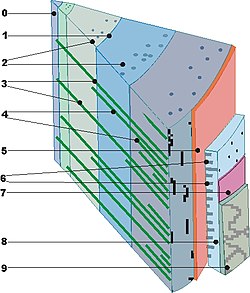Cambium

0 mark , 1 annual ring border , 2 resin canals , 3 primary rays , 4 secondary rays, 5 cambium , 6 rays of the bast , 7 cork cambium , 8 bast , 9 bark
Cambium (Latin cambium = change) is the layer of tissue that is responsible for the growth in thickness in plants . In trees it is the hollow cylindrical growth layer between the sapwood zone and the bark ( bast zone and bark ), which is also called the cambium ring .
This layer is responsible for secondary shoot growth ( growth in thickness ). In contrast to the primary apical meristem , it can be called a secondary or lateral meristem. It lies between the xylem (inside) and the phloem (outside). In most of the monocotyledonous plants there is no cambium in the vascular bundle (xylem / phloem), which is why these are not capable of secondary growth in thickness in the form of the dicotyledonous plants.
In an early stage of development of a dicotyledonous plant, the cambium is only available as a so-called fascicular cambium and is located within the vascular bundle ( Latin: fasces ). In the course of further development - via hormonal influences and remeristematization - further meristematic tissue emerges from the already differentiated cells of the parenchymatic medullary ray tissue at the level of the fascicular cambium. This is called the interfascicular cambium. Fascicular and interfascicular cambium together form the closed cambium ring of a dicotyledonous plant.
There are monocotyledonous plants, such as palms , that have a massive primary growth in thickness. However, this is done through the apical meristem. As a result, the shoot has almost its maximum diameter from the start. Some monocotyledons show an apparent secondary growth in thickness due to vegetative growth and the addition of dead leaf sheaths . This occurs, for example, with palm lilies , dragon trees or elephant feet. For a secondary growth in thickness, a closed cambium ring is required, which forms and releases new cells inwards and outwards evenly along the entire circumference. The part of the cambium ring that is already present, which lies between the xylem and phloem within the vascular bundle, is called the fascicular cambium . In order to create a closed cambium ring, the parenchymal cells of the medullary rays are remeristematized by hormonal stimuli and subsequently form a so-called interfascicular cambium .
According to the definition, all tissue that is deposited inwards by the cambium is called wood (= secondary xylem) (regardless of the lignification ) and all tissue that is deposited outwards is called bast (= secondary phloem). An additional cambium, the secondary cork cambium (phellogen), can develop in the bast .
literature
- Andreas Bresinsky , Christian Körner , Joachim W. Kadereit , Gunther Neuhaus , Uwe Sonnewald : Strasburger - textbook of botany. 36th edition. Founded by E. Strasburger. Spectrum Akademischer Verlag, Heidelberg 2008, ISBN 978-3-8274-1455-7 .
- Wolfram Braune, Alfred Leman, Hans Taubert: Plant anatomical practical course I. For an introduction to the anatomy of seed plants. 9th edition. Spectrum Akademischer Verlag, Heidelberg 2007, ISBN 978-3-8274-1742-8 .
Web links
- Further information at botany online
- Woody ancestors